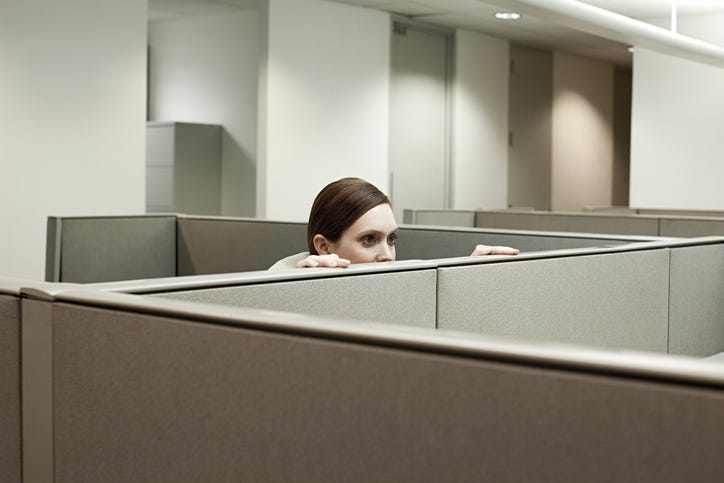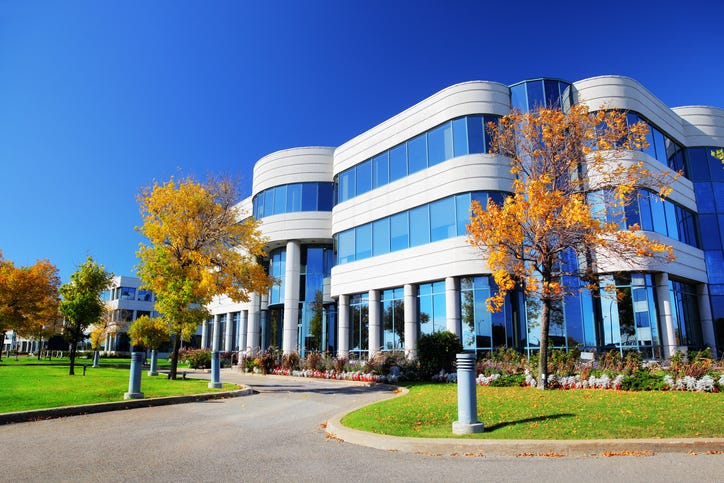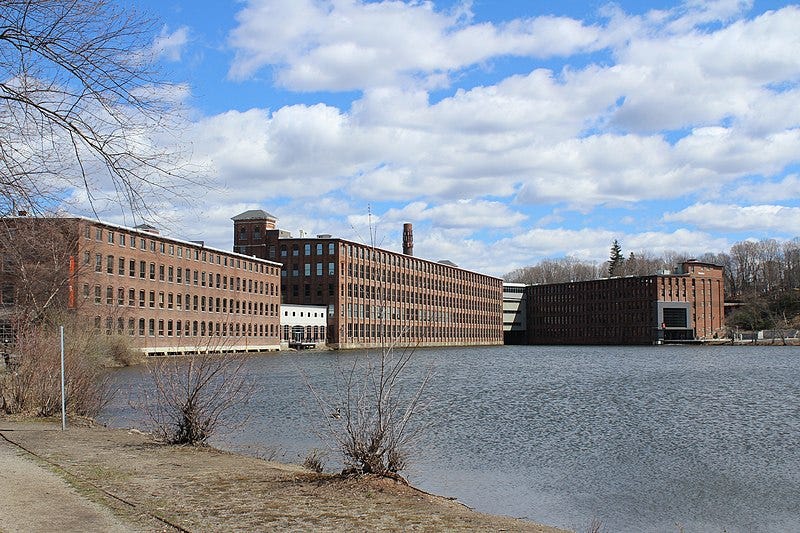Why I Miss Working in the Crappiest Places
I like my office like the Millennium Falcon: not much to look at, but has got it where it counts.
When the Pandemic hit, I was working in a brand new office complex we had just moved into four months earlier. The new place was far and above our previous digs, which were steeped in dated 1990’s decor, and which had no real amenities or walkable destinations for food or shopping.
Everything about our old building kind of whispered “decline”. The carpeting featured geometric purple triangles straight out of a 90’s music video, the lighting was a dull fluorescent flicker in many places. Our building sat amongst a half-mile stretch of vacant properties, whose previous tenants either went under or moved to greener pastures. Half of our building itself was vacant, and you could peer through windows in locked doors at a dark, unoccupied sea of cubicles.
The new place by contrast was part of a recently renovated complex that featured a full-service cafeteria with in-house Starbucks, basketball court, arcade games, full fitness center, and more. Even our private space had many more perks to offer: trendy-looking break room, recreation room with Nintendo games and ping-pong table, and lots of varied, collaborative workspaces.
Really this was just bringing our office up to par with what other tech areas like Silicon Valley have had for years. Our office is on the US East Coast, and it seems that for whatever reason, we are always the last in the country to implement any trend or to get say, a new store or restaurant. (I mean, our town only just got a Popeye’s Chicken last month, and there’s like a huge line for it all the time.)
The company had convinced itself that it would be better for attracting young talent if we moved to a site more comparable with what we had in other parts of the country. So they chose a large, modern multi-tenant complex in an area densely packed with tech companies, restaurants, retail stores, and apartment complexes.
It sounds like the right move, but I left off some key details in my description. The new location was only about ten miles south of the old one, but the intervening highway was one of the most traffic-congested spans in the entire state during rush hours. For most people, this translated to another half hour of commuting time, sitting in stop-and-go traffic.
The younger part of our workforce that had not bought a house or otherwise settled down somewhere pondered moving closer to the office. What they found was that their rent was going to double, if they wanted a similar-sized apartment in that commercial zone. Most people I knew quickly abandoned the idea and just inherited the extra half hour of commute time.
Then there was the office itself. At some point before our move, the management had to broach the delicate subject of how our new cubicles would be downsized, both in terms of area and wall height. When I started work at Digital Equipment Corporation in the 1980s, the cubes there were a (now ridiculously large) 10x10, with walls I would guess were five feet or more in height. Later these became 8x10 sometime in the 2000s, and in the new move, 8x6.
People groused about it. But for most, downsizing seemed inevitable, given how the rest of the tech world had transitioned to spaces this size or smaller long ago. The bigger concern the office staff had was about privacy, and a worry we would lose our cube walls entirely and go to the “open office” plan one of our other new buildings in California had used a few years back. There was a lot of feedback sent to the architect of the new site about a concern for privacy, and what we ended up with is a compromise, with slightly shorter walls and more open doorways, but not an entirely open / low-wall system.
Reduced privacy though turned out not to be an issue. Because the new office was not really occupied at anywhere near the same level as the previous one. Our company has long had a pretty liberal approach to telecommuting, leaving it up to the individual managers to set a policy. Our site did have a fair number of 5-day office regulars, but also a lot of people who telecommuted mainly but still worked in the office for some unspecified number of days a week. After the move to the new site, that “unspecified number of days” began to trend towards zero.
And it wasn’t just the old-timers with long commutes and families like me that were staying home. The younger employees, who were the most excited initially about the new office space, were also showing up a lot less. What had happened, wondered the planners of this move? Pretty much just a preview of coming attractions. By March of 2020, even the most reliable office-goers would be forced to abandon ship and discover their new, home-office lives. But in our case, it felt like the verdict on the new space was already in, even before the Pandemic.
Maybe analyzing it all now is a moot point, given how things have gone the past year and a half with the huge shift to telecommuting everywhere. But for me at least, I can say during my short time in a modern office complex, that I missed that crappy, dreary old office of ours. It was easy to get to, had big opaque walls and pleasant-for-coding, dim lighting. The fact that it was a dump was somehow also compelling. It may have been a dump, but it was our dump, and I secretly reveled in the appalled looks we would get from corporate visitors from the west to that site.
I probably also liked the old office because I’d been trained for the past twenty years to like crappy offices.
Why They Cut The Wheels Off My Chair
While the New England area seems to always be behind in getting the latest trends, it is a leader in figuring out what to do with the old ones. In the 19th century, New England was the technological capital of the world, spearheading the industrial revolution with an impressive manufacturing capability. Thanks to abundant hydropower, mills producing textiles, furniture, machinery, and household goods sprang up everywhere.
Large numbers of people came with their families to work in these mills, spawning cities that still exist today. Most of the manufacturing left the area in the 20th century, but the mill buildings remained. Many fell into disrepair, burned down, or were otherwise abandoned. But many were repurposed, especially during the start of the electronics age.
My original employer, Digital Equipment Corporation, made its headquarters in such a mill, a large rambling complex of buildings originally built in the late 1800s to produce textiles, including blankets for the civil war. In the early 1990s, I spent a few years working at this amazing site.
I joined the Alpha Workstations group in Digital in 1991 as it was forming, and we all moved into a space on the 6th floor of Building 3. This was the top floor of the building and was once used as storage for wool bales. The floors here were quite uneven, bowing down in the center and up at the walls, and generally undulating in the other direction as you walked the long halls. Varying theories circulated as to why.
Some said it was just the age of the building, some said the weight of things stored there caused the bending, but my favorite theory I heard was it was due to lanolin, a natural wax produced by sheep that is present in wool, and which has a softening effect on things. Whatever the reason though, it created a pronounced list in a lot of the offices, especially mine which happened to be near a wall.
When I moved in I found the filing cabinet was shimmed with small pieces of wood to level it, so the drawers would not just roll open. When I swapped the existing rickety chair in the office for one I brought, I quickly learned that it would roll away from my desk when I sat down. I inspected the original chair that came with the office and discovered that someone had taken a saw and cut off the bottoms of all the wheels, to prevent it from rolling.
I stuck with that rickety chair, and learned a lot about the other oddities of the building. In the summer, the air conditioners on the roof leaked, and so we had plastic sheets to protect our monitors from shorting out. Office walls were just painted plywood, with almost no sound deadening, so you would hear everything going on everywhere. Navigation through the building could be tricky, even for a seasoned pro. In some spots more than 4 hallways intersected, and catwalks from one building to another did not start and end on the same floor.
The young people who comprised the Alpha Workstations team seemed to just revel in it all. I don’t recall anyone honestly complaining about the quality of the accommodations in a serious way. We all just accepted that the “historic” nature of this site came with a lot of weird things you had to adjust to. And not all of them were bad.
I personally took advantage of the fact the complex was so large and sprawling, by deliberately scheduling mandatory manufacturing reviews (which I hated and I really didn’t want a lot of people to show up for them) in conference rooms in obscure, far-away buildings. People would either get lost trying to get there, or just skip the meeting so they didn’t have to find it. Those reviews went smoothly!
The other great thing about DEC’s Mill was that the town was literally built around the site, so when you stepped out of the building, you were in the middle of Main Street. Right next to the Post Office, shops, restaurants. It was a tight symbiotic community, still functioning as it was intended over a hundred years after being built. When Digital shut down the site in the late 1990s, the town was devastated.
We moved to a nearby (but more remote) modern office building that had many more amenities, but lacked any kind of character, and was not really built to be part of a community. Everyone I knew missed the Mill.
A River Runs Through It
I left DEC a few years after that, to work for a company started by ex-DECies. They must have missed the Maynard Mill, because their startup had chosen another old mill building for their company. Much smaller and maybe not as old as the Maynard complex, but definitely with as much character. This particular building backed right up to the pond that used to supply its power, and a small waterfall ran down next to one side of the building, physically touching it at times.
We had a spring flood once, and the water reached a point where we could see it arcing over the windowpane of our conference room. In what was most certainly bad Feng shui, the water also ran under this particular conference room, and we had a little trap door in there you could open and look down at the rushing river. (Our founder and a senior manager had to be stopped from whitewater rafting down the waterfall, because of the decapitation risk of the bridge that was downstream.)
The landlord here had no business renting this building out as an office space, it was really a cash grab on his part and capitalizing on the tech boom of the time. It was rundown and smelled faintly of diesel fuel. All sorts of denizens infested the building, including mice (the appearance of which prompted an office procedure whereby my friend Keith would be called in to dispose of them) and also Dobsonfly Larvae that probably were native to the river.
For those who have not had the pleasure, see picture below. Scale here is like over three inches, and you haven’t had an exciting day at work until one of these bad boys has dropped from the ceiling onto your desk while running regressions! Makes you think about Star Trek’s Chekov and his ear-loving Ceti Eel.
OK. Looking back, that one is objectively horrifying, and I don’t really miss it.
But I miss working there in general, and even when the Dobsonfly visitors broke up the day, it gave us something to talk about. The outdoor views, as shown, were spectacular, as was the walk down the railroad tracks ten feet behind the building. (Visitors from Silicon Valley would have to be reassured when the building started shaking from an approaching train though.)
We eventually got bought by a bigger company and when corporate came out to assess whether to upgrade the site or move, they were horrified. They quizzed our CEO about the ventilation system, and how we had just random vents hanging from 100-year-old beams, with no suspended ceilings to facilitate “air return”. Where were the emergency shutoffs for things? Our CEO looked around and shrugged. No one had any idea. We also had a kind of large algae situation on one facade that faced the river which was not particularly attractive. It was obvious that the Suits felt the building did not project the proper image to customers and employees.
Then they started talking about the rent. How much were we paying, the assessment team lead asked? Our CEO said (if I remember) $17 per square foot.
“$17/sqft per month? That’s really not that cheap, about the same as in the Valley!”, the corporate guy exclaimed.
Then our CEO clarified that our rent was $17 per square foot per year, not per month. Which kind of put a damper on the whole “It’s cost-effective to be in a modern building” discussion. In the end, we were moved to a much more expensive building, that everyone hated a lot more. But it looked marvelous.
This is kind of where I’d like to end today. It’s really hard to explain the appeal of crappy buildings, but people do just fine in them, even thrive, if the building has “good bones”. And crappy buildings are cheap, as it turns out.
None of us know who is going back to the office, when, or if. Given that, I would say if you are starting a company or moving one, consider the crappy building. Save some money on the lease at least, just in case no one decides to come back. And for those who do return, there are stimulating activities, like cutting wheels off chairs and dodging monstrous insects from above!
Explore Further
Next Time: A companion piece perhaps to my Ode to Radio Shack. Let’s talk about another lost friend from my childhood, Heathkit, and how the original go-to company of the Makers set the bar for customer experience in: What a Long-Dead Company Taught Me About UX Design
It’s a hard sell getting people to sign up for more email, I know. But think about it: What do you have to look forward to in your Inbox? It could be the Mad Ned Memo! Get your weekly dose of nerdy computer stories and discussions, nestled right in there between your credit card bill and UPS shipping delay notification. The Mad Ned Memo is ad-free and cost-free, and you can unsubscribe at any time.
The Mad Ned Memo takes subscriber privacy seriously and does not share email or other personal information with third parties. For more information, click here.






